Think of the blue flowline shown in your figure as a wire. If one were to place a wire along that path, a current would flow in that wire because the wire is another winding on the toroidal core of the drive coil. The magnetic flux through the wire loop changes and thus there must be electromotive force induced in the loop. The greater the conductivity of the liquid, the greater the current for a given emf. Of course, the conduction current in the liquid will follow many paths, or rather a continuously distributed path; think of all these paths as windings on the drive core.
Next, the liquid paths enclose both cores, the core of the receive coil and that of the drive coil. So, changing currents in the "liquid windings" will induce an emf in the receive windings. You get an ac current in the receive coil that is proportional to the conductivity of the liquid.
The system is akin to a three-coil transformer. Primary (drive) induces current in the secondary (liquid), which, in turn, induces current in the tertiary (receive). The net effect, the ac voltage in the receive coil, is proportional to the excitation and the product of the mutual inductances: \$M=M_{12}\cdot M_{23}\$. (Of course there is also \$M_{13}\$, but it is usually minimized in this type of sensor by placing mu-metal shielding between the toroids.)
Recall that in a transformer, the mutual inductance is a constant that is only related to the winding geometry and does not depend on frequency. In an ideal transformer, a voltage waveform applied to the primary passes straight through to the secondary (and, in this case, the tertiary), only multiplied by the turns ratio and unperturbed by frequency-dependent distortion.
So, in the zeroth approximation, it doesn't matter at what frequency you drive. In the first approximation you take into account self-resonance in the three coils; you'll only be able to excite the drive coil if the frequency is below its self-resonant frequency.
In the next approximation, you want signal to be above noise. Noise in liquids, and in the measuring apparatus that is connected to the receive coil, usually has a \$1/f\$ component, and liquids are notorious for strong \$1/f\$. So, you want your drive frequency to get above the \$1/f\$ noise knee, whatever it is in your system. Thus the answer: Drive as fast as you can while staying below attenuation brought along by self-resonance. In other words, keep increasing the drive frequency until you start getting less output.
One last note that may be irrelevant to your situation. To the best of my understanding of Maxwell's equations, I believe an electrodeless conductivity sensor doesn't just measure the ionic current. It measures the sum of the ionic and the displacement currents. As the frequency increases, the contribution of the displacement current increases, due to the time derivative in front of \$\bf D\$. Water has a relatively high relative permittivity. So, if you have a relatively low ionic conductivity and a relatively high frequency, you may end up measuring the displacement current and not the ionic current.
 EDIT: Added picture to question. Picture taken from: http://www2.emersonprocess.com/siteadmincenter/PM%20Rosemount%20Analytical%20Documents/Liq_ADS_43-018.pdf
EDIT: Added picture to question. Picture taken from: http://www2.emersonprocess.com/siteadmincenter/PM%20Rosemount%20Analytical%20Documents/Liq_ADS_43-018.pdf